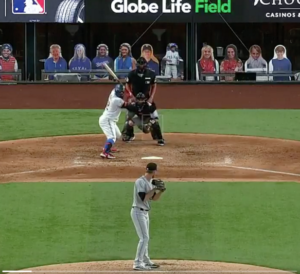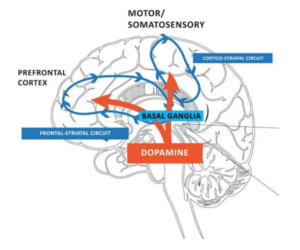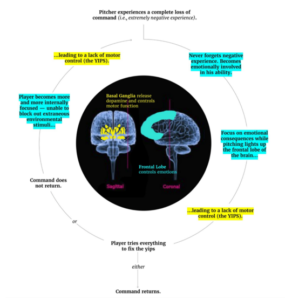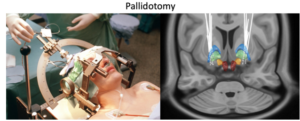 On Saturday, Colorado Rockies’ Daniel Bard clocked 99mph in a Rockies win against the Texas Rangers. Most would think the cardboard fan cutouts behind home plate would have been the biggest talking point. Bard only worked 1 1/3 innings and threw 25 pitches… but Bard’s story is quite a doozy.
On Saturday, Colorado Rockies’ Daniel Bard clocked 99mph in a Rockies win against the Texas Rangers. Most would think the cardboard fan cutouts behind home plate would have been the biggest talking point. Bard only worked 1 1/3 innings and threw 25 pitches… but Bard’s story is quite a doozy.
Never heard of Daniel Bard? Maybe it’s because his last MLB game was in April 2013, 2,646 days ago. Early in his career with the Red Sox, he was an effective reliever, potentially transitioning to a starter, but then he suffered what many call-in sports… “the yips”. He went from a 1.93 ERA to 6.22 ERA because throwing a baseball no longer was automatic.
 There is no medical definition of the disorder. It’s surely not what Bob Uecker satirized with Ricky Vaughn’s poor vision. The yips was first described as an occupational cramp in 1977, impacting professional golfers. In golf, the yips were described as being a psychoneuromuscular disorder usually affecting putting. This is accompanied by anxiety. In baseball, the yips mostly involves pitchers, where they have a sudden inability to throw the ball accurately. Not only can they no longer throw a strike, but they also can’t even get the ball close to the catcher.
There is no medical definition of the disorder. It’s surely not what Bob Uecker satirized with Ricky Vaughn’s poor vision. The yips was first described as an occupational cramp in 1977, impacting professional golfers. In golf, the yips were described as being a psychoneuromuscular disorder usually affecting putting. This is accompanied by anxiety. In baseball, the yips mostly involves pitchers, where they have a sudden inability to throw the ball accurately. Not only can they no longer throw a strike, but they also can’t even get the ball close to the catcher.
There seems to be two different types of yips, although likely overlapping. Type II is considered frank “choking”, and is nearly completely psychologically based. Dontrelle Willis may be the best example of Type II. Interestingly, studies involving Type II yips demonstrated no difference in the perceived anxiety level of athletes with or without yips during their performance. However, Type I is thought to be neurologically based as a form of focal dystonia. This is associated with higher intensity practice, concentration, tension, and years of competition.
The development of yips, or any disorder with an anxiety component, seems to be linked to a history of traumatic experience. In baseball, pitchers afflicted with the yips seem to have at least one prior bad outing that they cannot shake off. Additionally, individuals affected by Type I yips seem to invest considerable time and obsession with the experience, specifically focusing on the negative outcome and potential causes.
Focal dystonia is a neuromuscular movement disorder whose symptoms include involuntary muscular contractions resulting in twisting and repetitive movements or abnormal postures in one body part and during a performance task. Tasks affected by focal dystonia often involve highly repetitive motor skills. Dystonia-affected sports include golf, baseball pitching, table tennis, pistol shooting, and tennis. Probably the most famous MLB pitcher in recent memory affected by yips was St. Louis Cardinal’s Rick Ankiel in 2001. Most know him best now as an outfielder since he was never able to completely overcome his yips and return to pitching.

Click to enlarge
Focal dystonia may be from damage to the basal ganglia or other areas of the brain controlling movement. These are not primary movement centers, but regions that “fine-tune” motor functions. The intention to move initially happens in an area of the brain called the supplementary motor area (SMA). Signals proceed to the primary motor area and then down parallel pathways. One pathway is to the basal ganglia where the movement is learned and fine-tuned. The other is through the spine to the extremities. It is this pathway to the basal ganglia where dysfunction and resultant yips may occur.
Unfortunately, there is no single effective treatment for the yips. Many remedies focus on meditation and mental rehearsals. A few case studies suggest activating the right cerebral hemisphere, possibly just by clenching the left hand, can help. In some sports, botox is a promising solution. Paralyzing certain muscles where abnormal contractions impede performance could be useful. However, in baseball, botox weakens surrounding muscles too much, despite remedyingerratic muscles, leading to poor overall execution. Pitching relies both on finesse and power. Furthermore, a pitcher’s forearm/ shoulder muscles protect the ligaments in the arm, so botox would just lead to Tommy John’s- like injuries.
Certain severe focal dystonias can be treated with neurosurgical procedures. Writer’s cramp and musician’s cramp can be treated by intentionally “burning” (we like the word “lesioning”) the basal ganglia or thalamus with a very carefully placed electrode. This is called pallidotomy or thalamotomy. Recent thalamotomy has been performed in a table tennis player with successful treatment of their dystonia. Non-destructive procedures like deep brain stimulation (DBS) could also be options. However even in focal dystonias without a known psychologic component, worsened or untreated depression/ anxiety has resulted after destructive or DBS procedures. Even if baseball yips is primarily a basal ganglia problem, underlying anxiety is surely a component and would not be treated with current surgical options.








